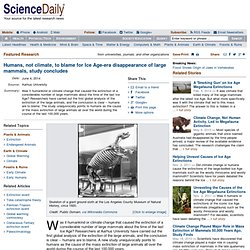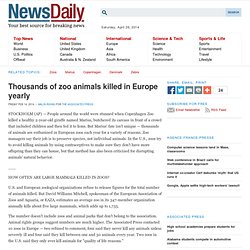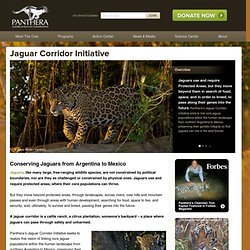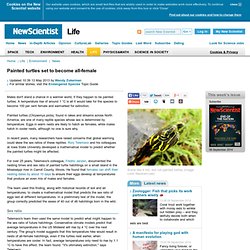

Humans, not climate, to blame for Ice Age-era disappearance of large mammals, study concludes. Was it humankind or climate change that caused the extinction of a considerable number of large mammals about the time of the last Ice Age?

Researchers at Aarhus University have carried out the first global analysis of the extinction of the large animals, and the conclusion is clear -- humans are to blame. A new study unequivocally points to humans as the cause of the mass extinction of large animals all over the world during the course of the last 100,000 years. "Our results strongly underline the fact that human expansion throughout the world has meant an enormous loss of large animals," says Postdoctoral Fellow Søren Faurby, Aarhus University.
Was it due to climate change? For almost 50 years, scientists have been discussing what led to the mass extinction of large animals (also known as megafauna) during and immediately after the last Ice Age. One of two leading theories states that the large animals became extinct as a result of climate change. Theory of overkill First global mapping. We are killing species at 1000 times the natural rate - environment - 29 May 2014. First the bad news.

Humans are driving species to extinction at around 1000 times the natural rate, at the top of the range of an earlier estimate. Inside the Global Industry That's Slaughtering Africa's Elephants - Matthew Scully. The scale of poaching is a criminal horror.

Why Obama should make it a priority issue -- in his meeting with China's Xi Jinping this week and beyond Members of the Pilanesberg National Park Anti-Poaching Unit (APU) stand guard as conservationists and police investigate the scene of a rhino poaching incident April 19, 2012. Thousands of zoo animals killed in Europe yearly. STOCKHOLM (AP) — People around the world were stunned when Copenhagen Zoo killed a healthy 2-year-old giraffe named Marius, butchered its carcass in front of a crowd that included children and then fed it to lions.

But Marius' fate isn't unique — thousands of animals are euthanized in European zoos each year for a variety of reasons. Zoo managers say their job is to preserve species, not individual animals. In the U.S., zoos try to avoid killing animals by using contraceptives to make sure they don't have more offspring than they can house, but that method has also been criticized for disrupting animals' natural behavior. U.S. and European zoological organizations refuse to release figures for the total number of animals killed.
5 Bizarre Animal Chain Reactions Our Daily Lives Are Causing. You've been hearing your whole life about how human progress means extinction for countless species -- usually due to humans just outright paving over their habitats or dumping poison into the water they swim in.

Gorilla & Chimp Conservation in Cameroon: Ape Action Africa. Jaguar Corridor Initiative. Conserving Jaguars from Argentina to Mexico Jaguars, like many large, free-ranging wildlife species, are not constrained by political boundaries, nor are they as challenged or constrained by physical ones.

Jaguars use and require protected areas, where their core populations can thrive. But they move beyond protected areas, through landscapes, across rivers, over hills and mountain passes and even through areas with human development, searching for food, space to live, and security, and, ultimately, to survive and breed, passing their genes into the future. 16607-1375118376-23. A brick that lets threatened birds build nests directly into walls. Birds build nests in the oddest of places.

"You often find them nesting under loose tiles or in old broken vents in the side of buildings," says Aaron Dunkerton, an England-based designer. But as buildings are patched up to improve insulation and green space disappears due to urbanisation, sparrows are losing a sizable chunk of their nesting options. Over the last three decades, the UK house sparrow population has decreased around 70 percent, and the bird has found itself on the growing list of endangered species. Conservation. Fuck the circus! Painted turtles set to become all-female - life - 03 May 2013. Males don't stand a chance in a warmer world, if they happen to be painted turtles.

A temperature rise of around 1 °C is all it would take for the species to become 100 per cent female and earmarked for extinction. Painted turtles (Chrysemys picta), found in lakes and streams across North America, are one of many reptile species whose sex is determined by temperature. Eggs in warm nests are likely to hatch as females, while males hatch in cooler nests, although no one is sure why.
In recent years, many researchers have raised concerns that global warming could skew the sex ratios of these reptiles. Rory Telemeco and his colleagues at Iowa State University developed a mathematical model to predict whether the painted turtles might be affected. Rainbow toad: Found after 87 years, first photo ever. Peoples Way Wildlife Crossings - Montana. How fairy wasps cope with being smaller than amoebas. Thrips are tiny insects, typically just a millimetre in length.

Some are barely half that size. If that’s how big the adults are, imagine how small a thrips’ egg must be. Now, consider that there are insects that lay their eggs inside the egg of a thrips.